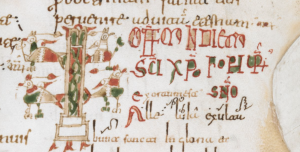This does not, I grant you, sound thrilling or valuable. But it was an unknown unknown to me until about six months ago, so the process of developing some sense of what it’s all about has been interesting and, if you like that kind of thing, fun. Briefly, the story is this. A liturgy, or liturgical rite, is a record of When and How Things Should Be Done in a church. This, very occasionally, comes to the fore in public discussion: what promises should be said during a wedding, for instance, comes – to some extent – back to a liturgical question. Can the content be changed for individuals, or at times of social change? (Answer: yes. The Christina religion has always been a flexible and response social process for aligning a faith community with different social, economic, and political communities.)
Now, most of you will know that the Catholic Church is a unified, single church because (pretty much) the same thing happens in all of its services and buildings. It’s like going to a chain pub: you know what you’re getting, even if the quality of service and décor varies a bit. This is because, over more or less precisely my period (ca. 600 – ca. 1200) and through a huge range of different processes, Rome came to dominate western European Christianity to such an extent that its particular liturgical form – the Roman Rite – became more or less the only one. Before that, there were several different forms knocking around.
If you think that doesn’t matter, glance at the Brexit debate. One of perhaps two hearts of the Leavers’ position is the desire to escape foreign dominance, regardless of what actual impact that has on daily life or cultural or economic experience. It would take an entirely different blog to properly reflect on this, but I think that the (Roman) Catholic Church was the EU of the medieval world – and I mean that in both positive and negative terms. Choosing to adopt the Roman Rite (as England did, with a particular focus on the date of Easter, in the seventh century) is to take a specific, Euro-centric (if you like) position.

Before the Roman Rite completely ruled the roost, there were some specific regional forms. These are sometimes called ‘the Gallican Rites’ as a collective, but as one of them is called ‘the Gallican Rite’, I haven’t found that especially helpful. So I go with the problematic term ‘pre-Roman Rites’ (problematic because the Roman Rite existed at the same time, and the name gives the impression that they were primitive – feeding into a view of history which believes that Time Eternally Progresses, and alos because it’s a pretty ugly term). The pre-Roman Rites I know about are the Gallican Rite (French), the Celtic Rite (Irish, but exported to everywhere an Irish bar now exists), the Ambrosian Rite (north Italian, centred on Milan), and the Hispanic, or Visigothic, or Mozarabic Rite (Spanish, centred on Toledo close to Madrid).
That’s a lot of rites.
These are interesting for me because my saint, Christopher, was included in the Ambrosian and Hispanic Rites, but didn’t make the Roman (until much later). As far as I can tell, not enough evidence exists to say whether he was or wasn’t in the Gallican or Celtic forms. And his story took radically different forms in each of those liturgical rites. So I now have a Spanish tradition and a north Italian tradition, reaching back to the sixth or perhaps the fifth century. This is pretty big news for me.
Who else cares? Well, if you’ve read this far then you’ve probably found the story interesting (or are eagerly looking forward to correcting me; please do). So you might just find it interesting in its own right (ha ha), which I think it is, too. I find it humbling (perhaps also humiliating) to discover such immense fields of information about the lives lived by vast numbers of people about which and whom I still know more or less nothing. Church liturgies sound arcane and irrelevant, I get that. But this is the rhythm of daily life, the tv soaps and football matches, for the vast majority of people who have lived in Europe for the last two thousand years. It’s always fascinating to see that Things Were Not As They Are. No-one practising the Gallican Rite in Lyons on a Tuesday in 703 AD would imagine that it would ever change, just as many today struggle with the idea of their church (or soap, or newspaper, or social media platform) changing. And the effort of finding out about these things has also been humbling. I’ve had to (try to) read things in French, Italian, Spanish, German, Latin, Greek translated into Latin. I’ve looked at loads of websites of individuals and institutions that I never knew existed. I’ve remembered – again – that to understand early medieval England, I’ve got to try to understand early medieval Europe. I’ve felt connected. I’ve felt tiny. And, just as I’ve started to feel that I’ve got some sort of grip on the outlines of what this particular vasty vista is all about, I’m going to have to turn away from it and work on something else, with the knowledge that this world lies in wait, with huge potential for future research and understanding.